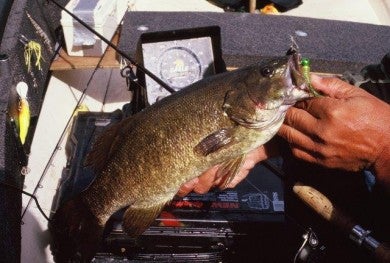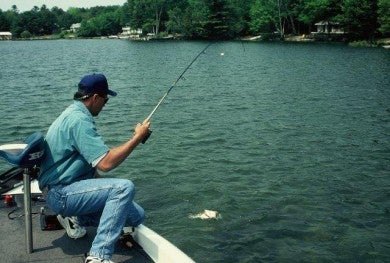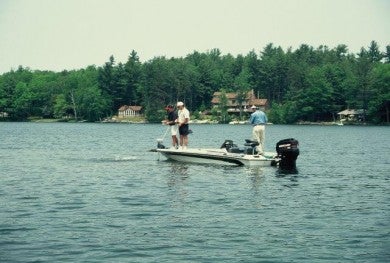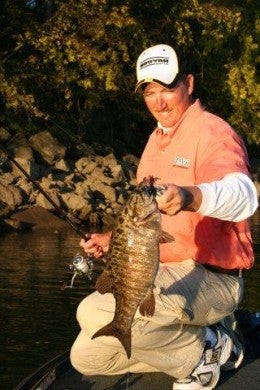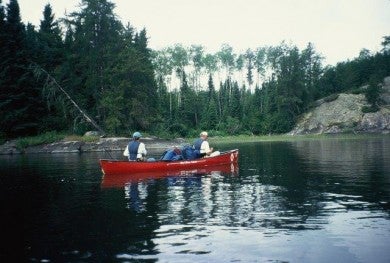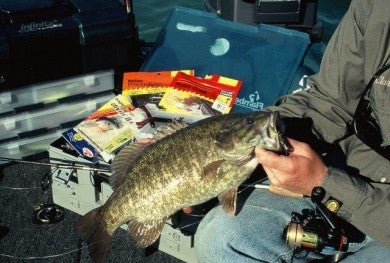Spring Smallmouth Bass Tactics
Bob McNally 05.27.15

More heavyweight smallmouth bass in the 4-, 6-, and 8-pound or larger class are caught in spring than in all the other months combined. But consistently catching big bronzebacks–even in spring–isn’t a piece of cake.
Outsize smallmouths are cagey and notoriously tight lipped. They’re deep-living, hard-to-reach fish through most of the year. Even in spring, when bass migrate to shallow water for spawning, most fishermen have little understanding where, when, and how to catch them.
Like many gamefish, smallmouths have some very rigid requirements for spawning. Anglers who know how to recognize prime bronzeback nesting sites can quickly determine where they should concentrate their spring fishing. Optimum temperature for smallmouth spawning is about 60 degrees. In spring, as water warms, fish migrate toward shallow flats that have course sand, gravel or small stones. The male fans a small depression or nest with its tail. Then he herds females to the nest where eggs are deposited and fertilized. The entire spawning procedure may last several days or a week or more depending on weather and water conditions.
It’s important to note that all smallmouths do not spawn at the same time. In fact, spawning bronzebacks can be found in prime bedding areas for a month or more on some waters. Further, even when bass are not actively spawning they can hold in general bedding areas for considerable time. Throughout the pre-spawn, spawn, and post-spawn phases, smallmouths can be in comparatively shallow water and will readily hit lures and baits. Thus a fisherman who recognizes smallmouth spawning water can have good fishing in those areas for a number of weeks.
Coves, shallow bays, extended sandbars, underwater points, and sheltered spots between and around islands are often selected by smallmouths for spawning. In clear lakes, bass may bed in water as deep as 20 feet, and in such cases night fishing frequently is most productive. In more turbid water, smallies may bed in just two or three feet of water. Areas with a lot of downed trees, overhanging brush, flooded stumps, and similar cover are preferred for spawning. However, if such cover is scarce, bronzebacks will even bed in open water on submerged, mid-lake islands or humps. But the bottom composition must of the type already described.
An ideal spring smallmouth spot would consist of a large bay with a number of islands, extended shoreline points, and sheltered flats. The bottom would have pea-size gravel, and there’d be plenty of half-submerged trees and possibly a few beaver houses. Water depth would range from two to 10 or 15 feet, and the entire bay would be reasonably close to large, deep, open areas of the lake or river.
In early spring, when smallmouths first begin moving to spawning areas, live baits are most productive. Small shiner minnows, nightcrawlers, large nymphs or hellgrammites, and crayfish are excellent bronzeback baits. At this time of year bass hold in slightly deeper water adjacent to flats where spawning is done later as water temperature rises.
One excellent way to fish natural baits is to drift or slow troll them along drop-offs near points at the mouths of spawning bays. Many skilled smallmouth anglers use “walking” sinker type terminal tackle set-ups, with the time-honored “Lindy Rig” the most common and successful one available. Trolling or drifting should be done very slowly, and it’s important baits are worked on the bottom.
Early season or pre-spawn smallmouths are not as aggressive, nor do they strike as hard as bass that are actively spawning. Usually a strike is felt as just a slight tap on the line or a “heaviness” is felt by an angler through the fishing rod.
As water temperature warms, smallmouths become more active and migrate onto flats where spawning is done. This is when artificials take their toll on bronzebacks. Natural baits still are effective, but a skilled fisherman will catch more and larger bass with lures as water temperature approaches 60 degrees.
Many lures are deadly takers of smallmouths, including small plastic worms, lightweight jigs, small in-line spinners, little spoons, blade baits, midget crankbaits, and top-water plugs. Bright-colored, flashy lures and ones imitating crawfish are favored throughout smallmouth country.
It’s important to vary lure retrieves until the right one is found for bronzebacks. Often slow retrieves are required, especially with spinners, but sometimes fast retrieves are productive, particularly with crankbaits that are made to bounce off bottom rocks and logs.
At certain times in late spring when bass are coming off their beds, smallmouths hold in loose schools near large spawning flats. Anglers who work ledges near flats often can locate such a school and catch many good-size bronzebacks in quick order. Crankbaits are excellent tools to search for post-spawn schools.
Tackle refinements are important for spring smallmouth fishing because it’s often done in clear, shallow water. When bass are present but are refusing lures and baits, it’s likely they see your fishing line, or your lure presentation is sloppy. Plunk a plug down on top of a smallmouth’s head in three feet of water and the fish is likely to spook.
Long casts and careful lure-bait presentation is called for when working shallows. Cast lures well beyond spots you believe hold bass, then retrieve artificials through the area. Boat noise should be kept to a minimum, too.
